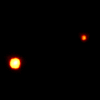
|
Diameter: 1,430 miles (2,300 km). |
|
Mass: 0.0022 Earth masses |
|
Rotation period: 6.4 days, retrograde. |
|
Inclination of equator to orbit: 123 degrees. |
|
Mean orbital speed: 3 Miles per second (4.7 km/s) |
|
Mean distance from the sun: 3.7 billion miles (5.9 billion km) |
| THE STRUCTURE OF PLUTO Pluto lies in the darkest reaches of our solar system, taking 248 years for it to orbit the sun, and it is 2.8 billion miles away from the sun when at its closest approach. It was discovered by accident in the 1930s when calculations, which later turned out to be in error, had predicted a planet beyond Neptune, based on the motions of Uranus and Neptune. Not knowing the error Tombaugh did a careful sky survey which turned up Pluto anyway. At the moment it is the furthest planet from the sun, but as its orbit is so elongated it is sometimes nearer to the sun than Neptune, as it was from January 1979until February 1999. There are also further oddities in that Pluto's orbital path is also markedly tilted from the plane in which the other planets orbit, and as with Uranus, Pluto orbits on its side. Pluto is the only planet in our solar system not to be visited by a space craft, making our knowledge of it relatively sketchy. However a space craft called New Horizons was launched in January 2006, which should reach Pluto in 2015. We do know that its diameter makes it the smallest planet in our solar system, smaller even than our moon. Pluto's mass is only one fifth of our earths, with a rock ice composition similar to that of Neptune's moon Triton. It is estimated that it is probably 70% rock and 30% water ice. Pluto's atmosphere may contain mostly nitrogen with some carbon monoxide and methane. It is extremely tenuous however and may exist as a gas only when Pluto is closest to the sun. The planet's surface temperature varies between approximately –390F and 346F. The unusual nature of the orbits of Pluto and of Triton and the similarities of bulk properties between Pluto and Triton suggest some historical connection between them. It was once thought that Pluto may have once been a satellite of Neptune's, but this now seems unlikely. A more popular idea is that Triton, like Pluto, once moved in an independent orbit around the sun, and was captured by Neptune. Perhaps Triton, Pluto and Charon (Pluto's moon) are the only remaining members of a large class of similar objects the rest of which were ejected into the Oort cloud. Like the earth's moon Charon may be the result of a collision between Pluto and another body. PLUTO'S MOONS Pluto has a close relationship with what was first though to be its single moon, Charon, so close in fact that some astronomers consider Pluto and Charon to be a double planet system. For one thing Charon is very large in proportion to the size of its home planet – its diameter of 745 miles is slightly less than half that of Pluto's, and it is also very close to its planet, orbiting every 6.4 days at a mean distance of only 12,500 miles. Additionally the masses of these two bodies are so close that they spiral around a shared centre of gravity that lies outside Pluto. In a normal planet–satellite system, such as the earth and the moon, the centre of gravity is near the planets centre. However in late 2005 a team using the Hubble space telescope discovered two additional tiny moons orbiting Pluto, each thought to be between 100 – 200 km in diameter. Pluto's unique features have led some scientists to believe that it wandered in from the Kuiper belt, a disc shaped region lying beyond the zone of planets. The bodies found there are icy planetismals, comets without tails. These never accreted into larger objects like Neptune because they orbit too slowly and there are lot enough of them to make planet building collisions likely. Pluto may be the largest example of this group. This has led some people to argue that is should be classified as a large asteroid or comet rather than a planet. Historically however Pluto has been classed as a planet and is likely to remain so, yet a recent discovery of an object that is almost certainly larger than Pluto (2003UB313) begs the question as to whether this should be classified as a planet too???
|
![]() Copyright(C) 2007
- 2020. All rights reserved.
Copyright(C) 2007
- 2020. All rights reserved.
